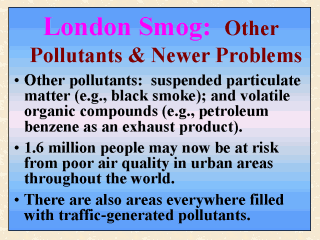| front |1 |2 |3 |4 |5 |6 |7 |8 |9 |10 |11 |12 |13 |14 |15 |16 |17 |18 |19 |20 |21 |review |
 |
In addition to
the 4 major air pollutants (sulfur dioxide, nitrogen oxide, carbon monoxide, and ozone)
discussed in the last slide, suspended particulate matter (PM10) and volatile
organic compounds (VOC) are also pollutants commonly studied by inhalation toxicologists
and air pollution epidemiologists. PM10 is a generic term for fine particles that are light enough to be suspended in air for hours to days. These solid and liquid particles commonly have effective diameters < 1 µm, but maybe up to 5 or 10 µm, and hence are typically within the inhalable range. Black smoke, that produced in the incomplete combustion of coal or oil, is one component of PM10. VOC as a group are also important because of their role as precursors, with oxides of nitrogen, in the photochemical formation of summer smog pollution. One VOC component of interest is, primarily for its direct toxic effects, petroleum benzene emitted to air as an exhaust product or through evaporative losses. Data on air pollution levels collected by the Global Environmental Monitoring System indicate that “As many as 1.6 billion people may be at risk from poor air quality in urban areas throughout the world (reported by the Hong Kong Government, Environmental Protection Department, as cited by Elsom, 1996)." Also pointed out by Elsom (1996), a professor of climatology at the Oxford Brookes University, is that congested areas likewise suffer high levels of traffic-generated pollutants, such as carbon monoxide, VOC, and nitrogen dioxide. Professor Elsom has provided an extensive review of the seriousness and causes of air pollution problems encountered by many cities worldwide. |